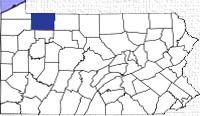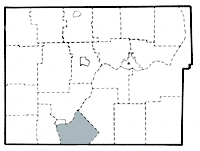

 |
 |
 |
||
Part of the PAGenWeb Project |
||||
 |
Limestone Township was formed from the provisional townships of Tionesta and Limestone in August, 1829.
Boroughs and Villages
Cemeteries
Church RecordsEarly History
Family Histories & BiographiesMaps
PhotographsSchoolsOther |
The links, below, are to the Limestone Township section in the Schenck History where the individual's name first appears; however, many of these pioneers are mentioned numerous times throughout this site. To find these additional entries, use the Find (Ctrl-F) search feature for this page or the Google search box on the Warren County Genealogy homepage to search the entire site. Pioneers and those who came later...
|
If you have any Limestone Township genealogy information you wish to share, please email the Warren County coordinator.
To aid in finding your ancestor, names below are in bold.
H I S T O R Y OF WARREN COUNTY PENNSYLVANIA WITH ILLUSTRATIONS AND BIOGRAPHICAL SKETCHES OF SOME OF ITS PROMINENT MEN AND PIONEERS |
Edited by J.S. Schenck, assisted by W.S. Rann; Syracuse, N.Y.; D Mason & Co., Publishers; 1887 |
CHAPTER XLI. |
HISTORY OF LIMESTONE TOWNSHIP. (1.) |
| (1.) By James Kinnear |
| LIMESTONE was formed from the provisional townships of Tionesta and Limestone (see chapter on township organization) in August, 1829. At this time the land was covered with large quantities of pine, hemlock and hard wood. Millions of feet of lumber have been manufactured in this township and run to market, and at the present day quantities of hemlock and some pine cover a large portion of its territory. The land is well watered, and abounding in never-failing springs in addition to the numerous tributaries of the Allegheny River which flow through this township. Years before the township was organized many settlers took up claims along the river, making settlers' claims, as it was supposed that this land was owned or controlled by the Commonwealth of Pennsylvania; but some time later, after many had spent years of hard work in clearing their lands and establishing homesteads, it was ascertained that a large portion of this land had been purchased by and belonged to an English landlord by the name of Maben, and although many of them strongly protested against buying their farms, after spending so many years of work thereon, all those whose farms chanced to be located on Maben's land were compelled to purchase them. This was done through Alexander McCalmont, agent. Other capitalists became owners of large tracts in this township and held the same for years. This retarded the settlement of Limestone, and the effect is still seen at the present day. A few coal mines have been opened and worked upon the more elevated tracts of this township, but with no great degree of success. There were few settlers in the township when it was organized, and these all lived along the river. The following are the names of parties living in Limestone at the time: Richard Arters, Robert Hunter, Arthur Magill, sr., James Middleton, Joshua Richardson, Alexander Magee, and Joseph Huff. Brief sketches of the lives of most of these old settlers will be found below. The first public road in Limestone township was laid out by order of the Court of Quarter Sessions of Warren county on the 24th day of March A. D. 1824. This road extended from the county line northward along the river to a point opposite the mouth of Tidioute Creek. Early Settlers.—One of the oldest, and perhaps the first permanent settler in Limestone township, was Richard Arters, who with his wife settled in Limestone in 1806. Here he cleared a small farm, which was located nearly opposite the lower part of Tidioute borough. His family was large. Hunter, Robert, another of the first settlers, was born in Ireland in 1758, and his wife, Elizabeth (Park) Hunter, was born in the same country in 1762. They settled in Limestone, then Deerfield township, four miles below the mouth of Tidioute Creek in 1808. Here they made their permanent home, and by industry and frugality succeeded in clearing a large farm. They had a family of ten children born unto them, consisting of six daughters and four sons, all of whom grew to maturity and married, most of them settling in Limestone and vicinity. Robert Hunter died in 1836, and his wife in 1843. Hunter, Mathew, the youngest son of Robert Hunter, was born in 1802, and after his father's death continued upon the old homestead. Here he farmed and lumbered as his father had done before,him. His wife, Sarah (Magill) Hunter, was born in 1809 and died in 1846. Mathew Hunter died in 1872. He had a family of ten children. In 1812 James Magee and wife moved from the eastern part of Pennsylvania to Warren county, and settled four miles below the mouth of Tidioute Creek in Limestone, then Deerfield township. His family, consisting of eight sons and two daughters, were mostly grown at the time they settled here, and they all afterwards settled in Limestone and vicinity. Magee, Henry, the seventh son of James Magee, settled three miles below Tidioute Creek, in Limestone township, as it is now called. He was one of the prominent men of that early day, and was instrumental in securing the organization of Limestone township. He was justice of the peace for many years, and held at different times all the official positions of the township. He married Kate Grandin and raised a large family. About the time of the oil excitement he sold his farm and moved west, where he died about the year 1884. Magee, Alexander, the youngest son of James Magee, was born in 1808. He settled four miles above Tidioute Creek in Limestone township. He was .a farmer and a lumberman, and a prominent man in his day. His wife, Nancy (Smith) Magee, was born in 1809. He had a family of five daughters, four of whom are still living and reside in Tidioute. Rebecca Magee married John Hunter, and Nancy Magee is the wife of W. C. Mabie. In the year 1854 the Harmony Society purchased about six thousand acres of land in Limestone township, from various parties, paying for the same a large amount of money, but nothing in comparison with what the land has since proved to be worth. Most of this land was well covered with timber, and a large part of it was found to be good oil territory, yielding immense quantities of oil, and affording the owners large profits. This territory was operated in the name of the Economy Oil Company, which company is identical with the Harmony Society, and only given another name in order to keep this part of its business separate and distinct. SKETCH OF HARMONY SOCIETY. The Harmony Society, a body of peculiar organization and interest, was founded by George Rapp and a colony of immigrants from Wurternberg, who sought in the United States an asylum from hostility to their religious views, and a place where they might enjoy freedom in the exercise of their own religious convictions, by the worship of God according to their understanding of his word. The basis of their association in its inception was a deep and earnest conviction of the necessity of a purer life, and the exercise of practical and personal piety, by a walk and conversation personally and socially in accordance with their understanding of the Scriptures. Entertaining similar views and convictions of religious duty and social economy (but views differing in some things materially from those of the recognized religious denominations and organizations of that day), it was natural the different individuals of the colony should be attracted toward each other, and unite for their mutual benefit and advantage ; and the causes and influences which thus first brought them together in an associated capacity have ever since operated as a bond that has held them united and firm in their adherence to the principles of the organization. One of the cardinal principles of the association was that of entire community of property, community of interests and labor, and mutual assistance of and dependence upon each other. A formal organization was first effected in 1805, at Harmony, Butler county, Pa., where they first located, by written articles of agreement, signed by all the members, whereby each delivered up and surrendered all property owned and held by him individually to the association thus established, thus forming a common stock or fund, joint and indivisible, held and managed by a trustee therein designated, for the common use and benefit of all members of the society; and bound themselves to submit to the rules and regulations established for the government of the society, and to labor for and promote the interests of the same; and also that if any should withdraw from the society for any cause whatever, those thus withdrawing should not make or have any claim or demand for the labor or services of themselves, their children or families, but whatever they might do or labor should be done as a voluntary service for their brethren, and for the common benefit. In consideration for what each thus voluntarily surrendered and contributed in property, labor, or otherwise, to the common fund, he or she became a member of the society, and entitled to all the rights and privileges of members to maintenance and support in health and in sickness, from the common stock or fund, and to the religious privileges and teachings, etc., etc., established and provided. In 1821, 1827, and 1836 respectively, further and additional agreements were entered into, being signed by all the members, whereby some modification of and additions to the original compact were made, for the furtherance of their views and wishes and the better establishment thereof, and of a more complete union, brotherhood, co-operation, and mutual assistance. George Rapp, who had been the principal founder of the society, its spiritual teacher, and also trustee of the property, died in 1847. After his death a new and more complete system of government for the society and the management of its property and affairs was ordained and established by the members, all of whom united therein and signed the written instrument in which the same is fully set forth. In none of these instruments or agreements, which were intended mainly for the better management of the social affairs of the society and its business with others, was there any departure from their views of entire community of property, labor and interests, adopted at their organization; but they reiterated this as one of their cardinal principles, declaring that all their property was, and was deemed to be, joint and indivisible, the property of the society for the common benefit of all its members, and this has always been regarded and maintained as one of the essential features of their compact. In 1814 and 1815 the society sold their property at Harmony, Pa., and removed to New Harmony, State of Indiana, where land was bought as the joint property of the society, and held and used for the common benefit of all under their compact. The location proving unhealthy, this was in turn sold, and in 1825 they removed to Beaver county, Pa., where land was again bought, held, and used as before, and where they still remain. The society has not escaped the fate of other similar associations, but there have been those of its members who became dissatisfied and withdrew, and who subsequently sought to recover from their former associates what they claimed they or their ancestors had put into the common stock, together with a proportionate share of the accumulations of the society, or if that could not be, then compensation for their labor and industry while they were members. Different suits were instituted for this purpose, some in the courts of the State of Pennsylvania, and others in the courts of the United States, wherein the affairs and management of the society were thoroughly investigated and the validity of the agreement or compact as originally entered into by the members, and as modified and ratified by the subsequent agreements, was fully and carefully examined by eminent counsel engaged on either side, and on most careful consideration sustained and established. Biographical.—Among the prominent citizens of Limestone township are William Merkle, superintendent of the Economy Oil Company; John Myres, farmer, owning one of the best farms in the county, consisting of two hundred acres, and located upon the river bottom within a mile of Tidioute; L. H. Sprague, J. H. McDonald, Michael Merkle, jr., Jacob Eisenbrown, Thomas Stroup, John Shoelkopf, T. A. McDonald, and W. S. Thompson. Houser, John P., was born in Venango county in 1819. He came to Limestone township in 1836. He purchased three hundred acres of land on tract 5225, of which he has cleared fifty acres. He was elected justice of the peace in 1864, and has held that position for five terms. He married Margaret Tuttle in 1843. They still reside on their farm about four miles from Tidioute. Their children now living are Ordelia Houser, born 1844, married W. J. Slater and lives in Watson township; John P. Houser, jr., born 1854, married and lives in Limestone township; Margaret E. Houser, born 1860, married C. A. Buchanan, and lives in Kane, Pa.; Carrie S. Houser, born in 1860 and resides at home. L. H. Sprague was born in Jefferson county, N. Y., in 1836. He came to Limestone township in 1860, and entered the employment of the Economy Oil Company. He married Cordelia Richardson in 1862. He has been constable and collector in Limestone for one or two terms. Kelly, Andrew, was born in Clarion county in 1820; he came to Limestone township in 1861 and purchased one hundred acres of land, most of which by hard work he has cleared and made tillable. In 1845 he married Elizabeth Kelly. They have had ten children born unto them. Those now living are Hannah Daubenspeck, John Kelly, Sharron S. Kelly, Flora Kelly, and Madge Kelly, who reside in Limestone township, and Samuel Kelly, who lives in Kansas. Averill, Sylvester, was born in Erie county, Pa., in 1819, and came to Limestone township in 1840; here he purchased one hundred and ten acres of wild land which he mostly cleared. He died in Limestone township in 1880. His wife, Hulda (Brown) Averill, still resides on the farm. Of the eight children born unto them there are living Lee Averill, who is married and lives at North Clarendon, Pa.; W. C. Averill, married Ufretta Gilmore and resides on the old homestead; Lunette Averill and S. H. Averill also reside in Limestone; S. B. Averill married and lives at Grand Valley. Shanley, John, was born in Canada in the year 1848, and came to Limestone in 1869. Since that time he has been in the employment of the Economy Oil Company. He served four years and ten months in the Union army before he was twenty-one years of age. In 1879 he married Belle Morrow, and has a family of four children; at present he is constable and collector in Limestone, which position he has had for two terms. The first oil well in Limestone was drilled by the Economy Oil Company in the fall of 1861, and proved to be a small well, yielding but two or three barrels per day. On Christmas day of the same year their first flowing well was struck. This produced about fifty barrels of oil per day. The oil business in Limestone township assumed large proportions from this time on; many different parties became interested, and large quantities of oil were produced. The Economy Oil Company alone drilled about seventy-five oil wells. The territory of Limestone township was lasting, and the quality of the oil-bearing sand was good, though the rock was not thick. The production from the old oil districts of Limestone has now dwindled down very low. New fields with small productions are now being operated in other parts of the township. The general business of Limestone at present is farming and lumbering. A number of saw-mills are kept runuing during a greater part of the year. Within the past few years a number of farms on the lands of the Economy Oil Company have been cleared, fenced, and made tillable. A few years more and the lumber will be gone, the oil exhausted, and then attention will be turned to clearing farms, and tilling the soil. Most of the land throughout this township will make fair farms. There is but one church in Limestone—a Union church, located upon what is known as Economite's Hill. In this church services are frequently held in German, to accommodate the German population living upon and working the lands of the Economy Oil Company. Religious services and Sunday-schools are held in nearly all of the school-houses throughout the township, under the direction of the Evangelical Association. Rev. M. V. De Vaux has charge of the work at present. About the time Limestone township was organized, half an acre of land on the McKean farm was donated for a public cemetery, and has been generally used since that time. In 1886 an association known as the Limestone Cemetery Association was incorporated, and purchased the old cemetery and land adjoining, placed the same in good condition, and opened it for public use. There are six schools in operation in Limestone township, and have an enrollment altogether of about one hundred scholars. The population of the township at present is about four hundred. |
Pages 493-498 |
Return to Warren County townships | Warren County genealogy homepage
A proud participant in the USGenWeb and PAGenWeb Projects
© 2010 - 2021 Penelope Repko and contributors
© 2008 - 2009 Bill Klauk and contributors